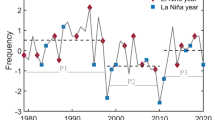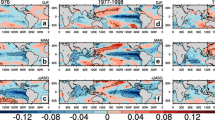Abstract
The relationship between the Asian-Pacific oscillation (APO) and the tropical cyclone frequency over the western North Pacific (WNP) in summer is preliminarily investigated through an analysis of observed data. The result has shown clearly that APO is significantly and positively correlated to the tropical cyclone frequency in the WNP. If APO is above (below) the normal in summer, more (less) tropical cyclones will tend to appear in the WNP. The present study also addresses the large-scale atmospheric general circulation changes underlying the linkage between APO and the WNP tropical cyclone frequency. It follows that a positive phase of summer APO is concurrent with weakened as well as northward and eastward located western Pacific subtropical high (WPSH), low-level convergence and high-level divergence, and reduced vertical zonal wind shear in the WNP, providing favorable environment for the tropical cyclone genesis, and thus more tropical cyclones will come into being, and vice versa.
Similar content being viewed by others
References
Chan J C L. Tropical cyclone activity in the Northwest Pacific in relation to the El Niño/Southern Oscillation phenomenon. Mon Weather Rev, 1985, 113(4): 599–606
Lander M A. An exploratory analysis of the relationship between tropical storm formation in the western North Pacific and ENSO. Mon Weather Rev, 1994, 122(4): 636–651
Tsutsui J I, Kasahara A. Simulated tropical cyclones using the national center for atmospheric research community climate model. J Geophys Res, 1996, 101(D10): 15013–15032
Saunders M A, Chandler R E, Merchant C J, et al. Atlantic hurricanes and NW Pacific typhoons: ENSO spatial impacts on occurrence and landfall. Geophys Res Lett, 2000, 27(8): 1147–1150
Chia H H, Ropelewski C F. The interannual variability in the genesis location of tropical cyclones in the Northwest Pacific. J Clim, 2002, 15(20): 2934–2944
Camargo S J, Sobel A H. Western North Pacific tropical cyclone intensity and ENSO. J Clim, 2005, 18(15): 2996–3006
Gray W M. Atlantic seasonal hurricane frequency: Part I: El Niño and 30 mb quasi-biennial oscillation influences. Mon Weather Rev, 1984, 112(9): 1649–1668
Jones C G, Thorncroft C D. The role of El Niño in Atlantic tropical cyclone activity. Weather, 1998, 53: 324–336
Namias J. Secular fluctuations in vulnerability to tropical cyclones in and off New England. Mon Weather Rev, 1995, 83(8): 155–162
Ding Y H, Reiter E R. Large-scale circulation influencing the typhoon formation over the West Pacific. Acta Oceanol Sin (in Chinese), 1983, 5(5): 561–574
Liebmann B, Hendon H H, Glick J D. The relationship between tropical cyclones of the western Pacific and Indian Oceans and the Madden-Julian oscillation. J Meteorol Soc Jpn, 1994, 72: 401–411
Chan J C L. Tropical cyclone activity in the northwest Pacific in relation to the stratospheric quasi-biennial oscillation. Mon Weather Rev, 1995, 123: 2567–2571
Ho C H, Baik J J, Kim J H, et al. Interdecadal changes in summertime typhoon tracks. J Clim, 2004, 17: 1767–1776
Lander M A. Special tropical cyclone track types and unusual tropical cyclone motions associated with a reverse oriented monsoon trough in the western North Pacific. Weather Forecast, 1996, 11: 170–186
Sun X R, Duan Y H. A study of the relationships between the East Asian summer monsoon and the tropical cyclone frequency in the WNP. Chin J Atmos Sci (in Chinese), 2003, 27(1): 67–74
Zhang Q Y, Peng J B. The interannual and interdecadal variations of East Asian summer circulation and its impact on the landing typhoon frequency over China during summer. Chin J Atmos Sci (in Chinese), 2003, 27: 97–106
Wang H J, Fan K. Relationship between the Antarctic oscillation and the western North Pacific typhoon frequency. Chin Sci Bull, 2007, 52(4): 561–565
Wang H J, Sun J Q, Fan K. Relationships between the North Pacific Oscillation and the typhoon/hurricane frequencies. Sci China Ser D-Earth Sci, 2007, 50(9): 1409–1416
Zhao P, Zhu Y N, Zhang R H. An Asian-Pacific teleconnection in summer tropospheric temperature and associated Asian climate variability. Clim Dyn, 2007, 29: 293–303
Landsea C W, Anderson C, Charles N, et al. The Atlantic hurricane database re-analysis project: Documentation for the 1851–1910 alterations and additions to the HURDAT database. In: Murname R J, Liu K B, eds. Hurricanes and Typhoons: Past, Present and Future. New York: Columbia University Press, 2004. 177–221
Kalnay E, Kanamistu M, Kistler R, et al. NCEP/NCAR 40-year reanalysis project. Bull Amer Meteorol Soc, 1996, 77: 437–471
Gray W M. Global guide of the origin of tropical disturbances and storms. Mon Weather Rev, 1968, 96(10): 669–700
Wang H J, Fan K. Southern Hemisphere mean zonal wind in upper troposphere and East Asian summer monsoon circulation. Chin Sci Bull, 2006, 51(12): 1508–1514
Fan K. North Pacific sea ice cover, a predictor for the western North Pacific typhoon frequency? Sci China Ser D-Earth Sci, 2007, 50(8): 1251–1257
Fan K. New predictors and a new prediction model for the typhoon frequency over western North Pacific. Sci China Ser D-Earth Sci, 2007, 50(9): 1417–1423
Author information
Authors and Affiliations
Corresponding author
Additional information
Supported by the National Natural Science Foundation of China (Grant Nos. 40631005, 40625014 and 40620130113)
Rights and permissions
About this article
Cite this article
Zhou, B., Cui, X. & Zhao, P. Relationship between the Asian-Pacific oscillation and the tropical cyclone frequency in the western North Pacific. Sci. China Ser. D-Earth Sci. 51, 380–385 (2008). https://doi.org/10.1007/s11430-008-0014-7
Received:
Accepted:
Issue Date:
DOI: https://doi.org/10.1007/s11430-008-0014-7




